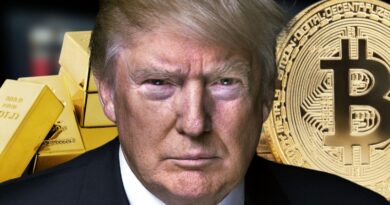Trump Criticizes Fed and Tariffs, Markets React with Sharp Decline
The stock market took a sharp dip recently, and it wasn’t just another routine fluctuation. This drop came after former President Donald Trump reignited two hot-button issues: criticism of the Federal Reserve and the tough stance on global tariffs. So, why does that rattle Wall Street—and what does it mean for your money?
What Exactly Happened?
Trump made headlines by slamming the U.S. Federal Reserve, accusing it of dragging its feet on interest rate cuts. At the same time, he hinted at reviving broad tariffs on imports if he wins re-election. The combination of those two declarations sent shockwaves through financial markets.
Investors quickly pulled out of stocks, leading to a sudden selloff. The market reaction wasn’t just noise—it reflected genuine concern about where the U.S. economy might be headed.
Why the Fed Matters So Much
Let’s talk about the Fed. You’ve probably heard of it, but why is it such a big deal when Trump criticizes it?
The Federal Reserve manages U.S. monetary policy. One of its biggest tools is setting interest rates. Lower rates generally promote borrowing and stimulate spending, which is often good for stocks. Higher rates can cool inflation but may also slow down economic growth.
Here’s what Trump claims: The Fed is “hurting” the economy by keeping rates too high. He argued that politically motivated decisions are stopping the country from achieving its economic potential.
To be fair, some investors agree with him. Rate cuts can buoy markets, at least in the short term. But Fed officials often move cautiously, trying to avoid long-term dangers like inflation or financial bubbles.
How This Impacts You
- Mortgage rates: If the Fed cuts rates, borrowing costs could drop, possibly lowering your mortgage or refinancing rate.
- Credit cards and loans: Cheaper borrowing sounds good, but rate cuts may also signal a slowing economy.
- Retirement accounts: Volatility in the stock market can impact your 401(k) or IRA returns.
What About the Tariffs?
Trump also revived talk about imposing new tariffs on imports. Tariffs are taxes on products coming into the U.S. They’re meant to protect American industries by making foreign goods more expensive. But they also raise prices for consumers and disrupt global trade.
He floated a proposal suggesting tariffs as high as 60% on Chinese goods. That’s unbelievably steep. Markets get jittery whenever trade war rhetoric heats up because corporate profits are at risk—and so are consumer prices.
Real-Life Example:
Think about shopping for electronics or clothes. If tariffs go up, companies often pass those costs to you. So, your next phone or pair of sneakers could cost more—not because it’s better, but because it’s taxed more coming in.
How Did the Market React?
Almost instantly, investors panicked. Stocks dipped and safe-haven assets like gold and government bonds rose. The market interpreted Trump’s comments as triple trouble:
- Fed rate-cut pressure = Uncertainty about monetary policy
- Tariff escalation = Risk of renewed global trade conflicts
- Election risk = Fear of drastic policy changes
Simply put, the comments weren’t just political talking points; investors saw real risk on the horizon. We also saw volatility indexes spike, a sign that traders expect a bumpy ride ahead.
Will the Fed Actually Cut Rates?
Not necessarily. While investors often try to predict or influence Fed decisions, the central bank usually follows economic indicators like inflation and employment numbers.
Still, political pressure can create an uncomfortable climate. If markets keep reacting badly, the Fed may face increased scrutiny—or even rush decisions to calm nerves.
For now, Fed officials have remained measured. They acknowledge current economic challenges but stress caution and data-driven decisions.
Want to Know More About Fed Strategy?
Check out our recent post on how the Fed navigates political pressure versus market expectations.
What Should Investors Do Right Now?
If you’re feeling whiplash from the headlines, you’re not alone. But making emotional decisions in volatile times can do more harm than good. Instead, consider these steps:
- Review your portfolio allocation: Make sure your investments match your risk tolerance and goals.
- Stay diversified: Avoid putting all your eggs in one basket. Spread out across sectors and asset classes.
- Think long term: Markets go up and down. Don’t let short-term noise derail your long-term plans.
- Stay informed: Keep up with news that affects your finances. Reliable sources can help separate signal from noise.
You might also find value in reading our guide on top investing strategies for navigating market uncertainty.
What If You’re Just Starting to Invest?
Don’t panic. Everyone starts somewhere, and confusing headlines shouldn’t scare you off. In fact, times like these offer great learning opportunities.
Try using a demo account or small investments to build your confidence. Apps like Robinhood or Webull offer easy access, but be sure to research and manage risk responsibly.
Curious about where to begin? Our article on best platforms for beginner investors is a great place to start.
The Bottom Line
When Trump talks, markets listen—especially when it involves the Fed or tariffs. While his comments may fire up his political base, they also stir financial uncertainty.
For investors, the key is not to overreact. Use this moment as motivation to reassess your strategy, understand your risk profile, and make informed decisions.
And remember, markets move in cycles. Staying calm—and staying informed—can make all the difference.
Want Weekly Market Recaps?
Stay up to date with our weekly market roundups for clear, concise updates on what you need to know—without the fluff.






